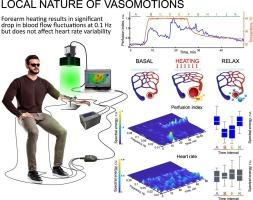利用成像光压描记术研究局部加热下微循环中的 0.1 赫兹血管运动
IF 4.9
2区 医学
Q1 ENGINEERING, BIOMEDICAL
引用次数: 0
摘要
人体循环系统的低频振荡对基础生理学和临床医学的实际应用都很重要。我们的目的是研究 0.1 赫兹左右的血流波动变化是由哪种机制(中枢机制还是局部机制)引起的。我们使用与心电图同步的成像光电血压计方法,测量了 18 名健康男性志愿者前臂局部加热时的血流反应。外周血流灌注的动态变化是通过对光敏血压数据的相关处理来揭示的,而中心血流动力学则是通过心电图来评估的。小波分析用于估算频谱成分的动态变化。我们的研究结果表明,皮肤加热会导致局部灌注的多次增加,同时伴随着 0.1 赫兹血流振荡的下降,而心率变异性没有发生变化。关闭加热后,无论皮肤温度如何下降,血流灌注仍保持在较高水平。0.1 赫兹的振荡平稳地恢复到基本水平。总之,我们证实了外周血流波动在 0.1 赫兹左右频段的局部性质。我们发现,在停止皮肤升温后,该频率范围内的波动能量会明显恢复,但会有时间延迟。这项研究揭示了一种参与调节微循环血管张力的新因素。利用与心电图同步的光电血压成像新技术对血液动力学进行全面研究,是开发有价值诊断工具的先决条件。本文章由计算机程序翻译,如有差异,请以英文原文为准。

Study of 0.1-Hz vasomotion in microcirculation under local heating by means of imaging photoplethysmography
Low-frequency oscillations in the human circulatory system is important for basic physiology and practical applications in clinical medicine. Our objective was to study which mechanism (central or local) is responsible for changes in blood flow fluctuations at around 0.1 Hz. We used the method of imaging photoplethysmography synchronized with electrocardiography to measure blood-flow response to local forearm heating of 18 healthy male volunteers. The dynamics of peripheral perfusion was revealed by a correlation processing of photoplethysmography data, and the central hemodynamics was assessed from the electrocardiogram. Wavelet analysis was used to estimate the dynamics of spectral components. Our results show that skin heating leads to multiple increase in local perfusion accompanied by drop in blood flow oscillations at 0.1 Hz, whereas no changes in heart rate variability was observed. After switching off the heating, perfusion remains at the high level, regardless decrease in skin temperature. The 0.1 Hz oscillations are smoothly recovered to the base level. In conclusion, we confirm the local nature of fluctuations in peripheral blood flow in the frequency band of about 0.1 Hz. A significant, but time-delayed, recovery of fluctuation energy in this frequency range after cessation of the skin warming was discovered. This study reveals a novel factor involved in the regulation microcirculatory vascular tone. A comprehensive study of hemodynamics using the new technique of imaging photoplethysmography synchronized with electrocardiography is a prerequisite for development of a valuable diagnostic tool.
求助全文
通过发布文献求助,成功后即可免费获取论文全文。
去求助
来源期刊

Biomedical Signal Processing and Control
工程技术-工程:生物医学
CiteScore
9.80
自引率
13.70%
发文量
822
审稿时长
4 months
期刊介绍:
Biomedical Signal Processing and Control aims to provide a cross-disciplinary international forum for the interchange of information on research in the measurement and analysis of signals and images in clinical medicine and the biological sciences. Emphasis is placed on contributions dealing with the practical, applications-led research on the use of methods and devices in clinical diagnosis, patient monitoring and management.
Biomedical Signal Processing and Control reflects the main areas in which these methods are being used and developed at the interface of both engineering and clinical science. The scope of the journal is defined to include relevant review papers, technical notes, short communications and letters. Tutorial papers and special issues will also be published.
 求助内容:
求助内容: 应助结果提醒方式:
应助结果提醒方式:


